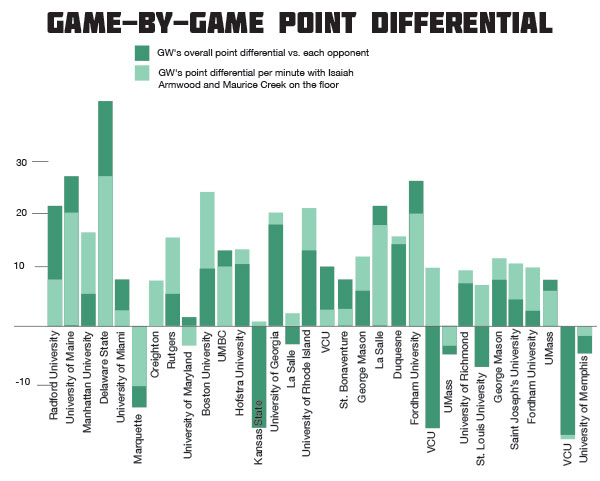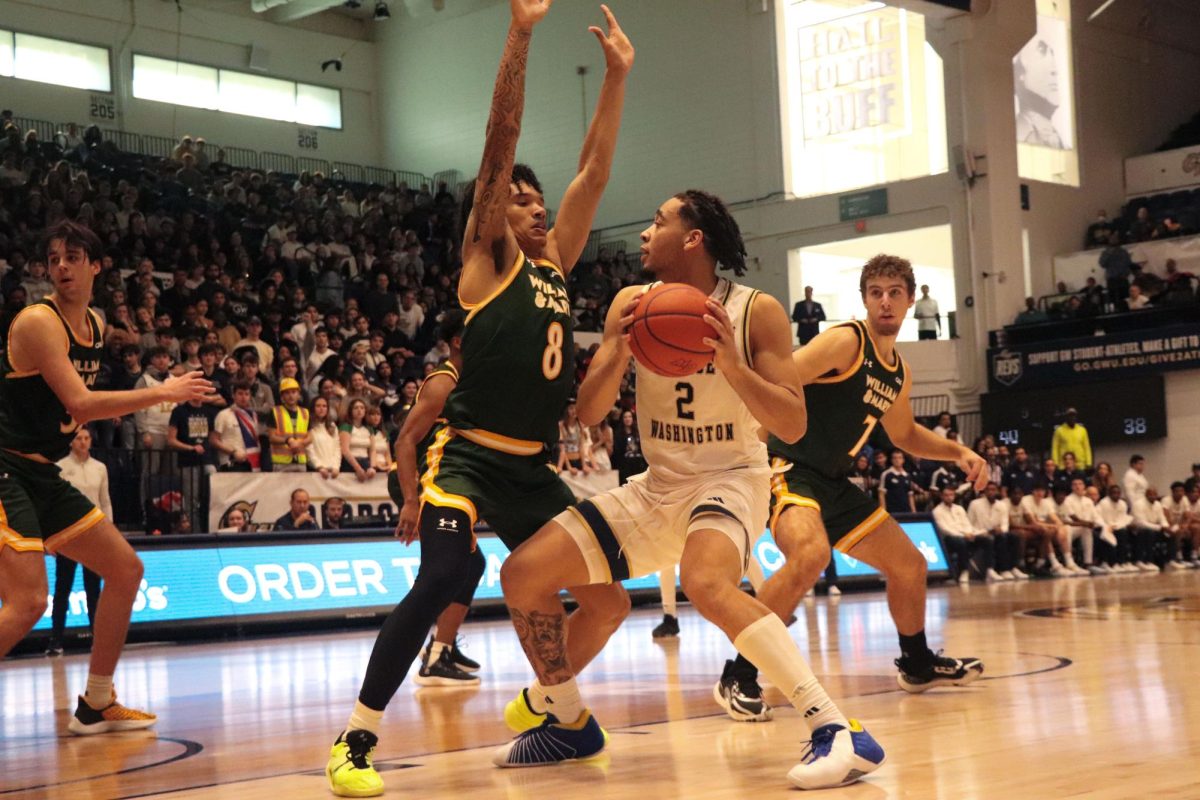The Zeek and Creek Show thrilled viewers with flashy dunks, big blocks and game-winning fadeaways.
Unfortunately for Colonials fans, that show has been cancelled – though not due to low ratings. Head coach Mike Lonergan has high expectations for his new leading men to step up and create star power of their own, but he has his work cut out for him.
“I told them, ‘Hey, you are going to be judged this season.’ We lost our two leading scorers,” Lonergan said.
Those leading scorers averaged a combined 26.8 points per game and 11.8 rebounds per game. Isaiah Armwood and Maurice Creek led the team to its first NCAA berth since 2007 before graduating.
The story of the team for 2014-15 is the story of life after Zeek and Creek, the story of a core group of players looking to dazzle again without two of their most visible playmakers.
The Zeek and Creek ratings
How valuable were Armwood and Creek to GW, from both sides of the ball? We looked at each player’s game-by-game success last season from a plus-minus perspective, seeing how successful the team was when the players were on the court.
We used several statistics, most notably the team’s point differential per minute when a player was on the court, to place value on individual players, and on Armwood and Creek in tandem.
An easy way to understand how dynamic the duo was is by looking at their point production. Creek led the team in scoring at 14.1 points and then Armwood followed with 12.7 points.
The two were also a force on the court in limiting other teams. Armwood was the most effective on his own, but the most potent force was the pair together.
On average, the Colonials scored .18 points per minute more than their opponents last season, or 7.2 points per game. When Armwood and Creek were both on the floor, GW outscored its opponents by more than double that, .41 points per minute or 16.4 points if extrapolated over a whole game.
Fighting back to win the final game of the regular season, Creek’s 24 points led the Colonials to a win against Fordham. But it wasn’t until Armwood’s two successful free throws that GW tied up the game late. Though the comeback was placed on the hot hand of the guard, it was the big man who anchored the win, with one of his most efficient games of the season.
The team finished the game averaging .345 more points per minute than the Rams with Armwood in, which was well over the GW value of .075. When Armwood was in the game, the Colonials outscored Fordham 57-47.
No one else on the team cracked .20 points per minute, and the GW bench was in the negative.
Creek may have played the hero on several occasions, like with his game-winner at the BB&T Classic, but Armwood’s production up front and team-best 32.0 minutes per game will be the most difficult to replace.
It was not uncommon to see the Villanova transfer play the entire second half of games: He did it four times, and 13 times he was subbed out no more than twice in the second half, sitting out for just 1:54 on average in those games.
Defensively, Armwood altered the game. He was a shot blocker whose presence pushed shooters out of the lane into low percentage mid-range jumpers or desperate threes.
Against Georgia in a big win, the Colonials averaged an even defensive rebounding differential. When Armwood was on the floor, they brought down 21 defensive rebounds, versus the Bulldogs’ 15, a .15 rebounds per minute rate.
Armwood was the fourth-best rebounder in the Atlantic 10 and led GW in rebounding with 8.4 per game, bringing down 276 total. Junior forward Kevin Larsen came next with 6.9 per game, followed by junior guard Joe McDonald with 4.6 per game.
With that, GW was ranked the fifth-highest rebounding defense in the league and the third-best rebounding offense, with the second-best margin.
How good was the team off the glass with Armwood in the game? They averaged a significant rebounding differential over opposing teams while he was on the court: GW out-rebounded their opponent by .15 of a rebound per minute, or six per game, on average during the season.
A new show starring ‘Kevin & Co.’
But the show must go on. A short bench, inexperienced and lacking in bigs, could be the biggest problem for GW, particularly in replacing Armwood’s minutes and rebounding. But Lonergan said the team will have to adapt to a “replace by committee” system.
“Nobody is going to replace Isaiah’s 12 and nine, we have to do it as a team,” Lonergan said.
Lonergan has a rough formula to replace the rebounding loss: Larsen needs to pickup 1.5 more boards per game, senior forward John Kopriva needs to improve by three and McDonald, or one of the other guards, needs to improve by close to one more rebound per game.
If they do that, then Lonergan has confidence his team could run a similar offense. Otherwise, getting easy opportunities in transition and running with the ball with athletic players might be the best way to go, he said.
Larsen rebounded at a similar clip to Armwood and, when McDonald was on the court, the Colonials rebounded at their best, averaging eight more rebounds per game than their opponents and gaining a 3.6 edge in offensive rebounds.
With McDonald fully recovered from hip surgery, Lonergan may have success in letting the high-flying guard attack the boards.
“I think I can rebound well at the point guard position, getting a couple more assists and just making sure I’m getting more efficient. You can never go wrong with that,” McDonald said.
Junior guard Kethan Savage will be the key to moving on without Creek. Lonergan feels confident in Savage’s ability to fill in that leading scorer’s role and hopes to see an increase in production from sophomore Nick Griffin, who showed signs of being able to become an outside scorer at different times last year.
In GW’s season-shaping win against Miami in overtime on Nov. 28, Creek could be characterized as the hero, with 15 points. McDonald also made the clutch layup in the closing seconds of regulation, and then-senior Nemanja Mikic nailed four of his five three-pointers.
But Savage was the most valuable scorer on the floor. GW scored .31 points per minute more than Miami while he was on the floor – putting him significantly above the team’s average of .18 points per minute.
On offense, Lonergan says he wants all of the “core four” juniors of Larsen, Savage, McDonald and guard/forward Patricio Garino to score in double digits. That would make up for some of Armwood and Creek’s point production, especially if Savage is healthy the entire year.
Some offense may also come from an unexpected source: Kopriva.
GW almost always scored fewer points than their opponents with Kopriva on the court, with the exception of the A-10 playoff game against VCU. Kopriva was the only player who logged over 10 minutes of playing time and was on the court when the Colonials outscored VCU, which they did 17-12 with him playing.
The Colonials will need more of that Kopriva to show up this season as he will jump into a starting role and team up with Larsen in the frontcourt. Kopriva says he’s ready to pick his shots and exercise an improved mid-range jumper.
But the real challenge will come when starters need rest or are in foul trouble. Lonergan said he dreads a situation in which Larsen gets into foul trouble and a short bench lacking in bigs with experience is forced to compensate.
“That’s scary, that really is,” Lonergan said.
What it comes down to
The Zeek and Creek show will be missed, but this year’s cast could prove to put on a better show overall. It depends on how Larsen handles the double team and how the Colonials counter potential Larsen foul trouble with young, inexperienced talent plus a veteran ready to contribute in Kopriva.
Savage is vital to fill in the role of go-to scorer who can shoot the trey and drive effectively. He was doing just that before his injury, when GW was most efficient as a team. If he and Larsen can get to the line often, it will bode well for the Colonials.
Members of the freshman class will also be tapped to provide production. Lonergan said forward Yuta Watanabe and guard Darian Bryant are the two freshman most likely to contribute to the team.
McDonald, now 100 percent healthy, will return to the lineup, which could be significant if GW elects to push the pace in games. Without Zeek and Creek, halfcourt offense might be more stagnant. With McDonald running the floor at full speed and able to dish to Wantanbe or Larsen, Garino or Savage, GW may be able to make up for a likely fall in rebounding by increasing in field goal percentage.
Garino’s biggest role with the departure of Zeek and Creek is to make sure his intense defense at the top of the 1-3-1 formation results in turnovers as Armwood will no longer be in the back of the defense to bail them out.
Without a dominant rebounder and shot blocker and influencer, teams may score more on GW per game. But it is also likely the Colonials will score more per game, too. The season is around the corner, but it looks like the show is programmed to be a success.








